Assignment On The Metoclopramide
VerifiedAdded on 2022/09/26
|9
|2290
|34
Assignment
AI Summary
Contribute Materials
Your contribution can guide someone’s learning journey. Share your
documents today.
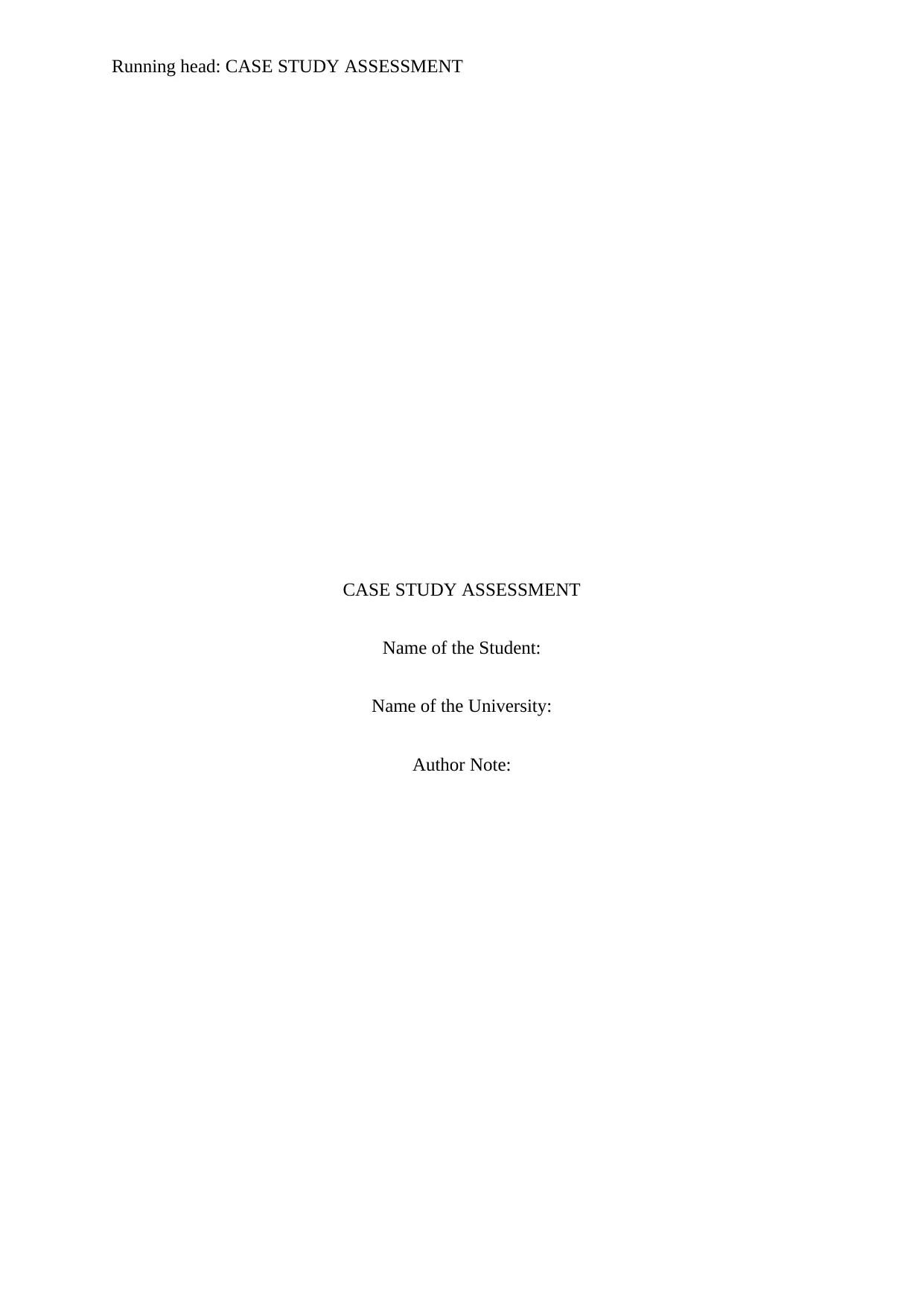
Running head: CASE STUDY ASSESSMENT
CASE STUDY ASSESSMENT
Name of the Student:
Name of the University:
Author Note:
CASE STUDY ASSESSMENT
Name of the Student:
Name of the University:
Author Note:
Secure Best Marks with AI Grader
Need help grading? Try our AI Grader for instant feedback on your assignments.
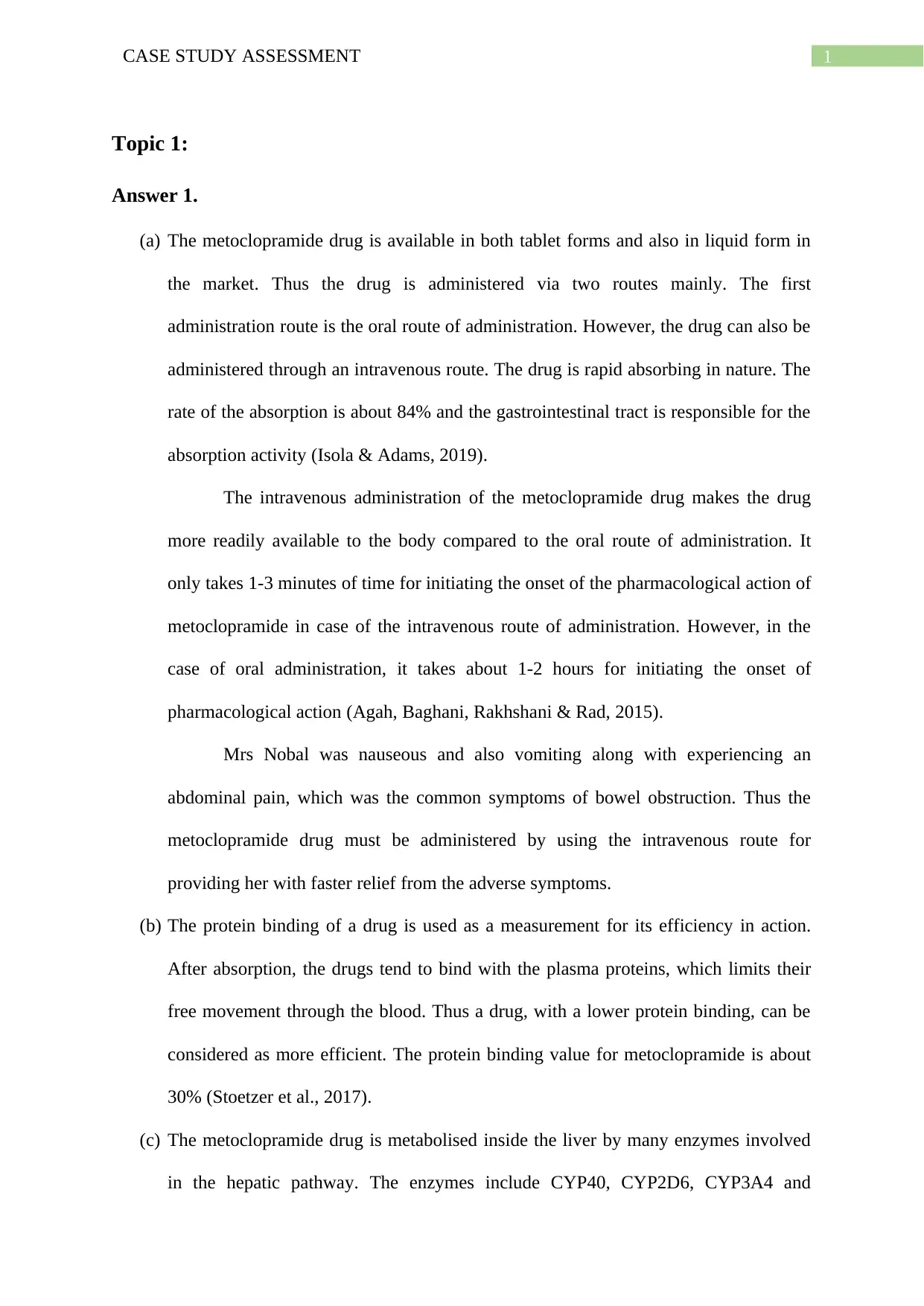
1CASE STUDY ASSESSMENT
Topic 1:
Answer 1.
(a) The metoclopramide drug is available in both tablet forms and also in liquid form in
the market. Thus the drug is administered via two routes mainly. The first
administration route is the oral route of administration. However, the drug can also be
administered through an intravenous route. The drug is rapid absorbing in nature. The
rate of the absorption is about 84% and the gastrointestinal tract is responsible for the
absorption activity (Isola & Adams, 2019).
The intravenous administration of the metoclopramide drug makes the drug
more readily available to the body compared to the oral route of administration. It
only takes 1-3 minutes of time for initiating the onset of the pharmacological action of
metoclopramide in case of the intravenous route of administration. However, in the
case of oral administration, it takes about 1-2 hours for initiating the onset of
pharmacological action (Agah, Baghani, Rakhshani & Rad, 2015).
Mrs Nobal was nauseous and also vomiting along with experiencing an
abdominal pain, which was the common symptoms of bowel obstruction. Thus the
metoclopramide drug must be administered by using the intravenous route for
providing her with faster relief from the adverse symptoms.
(b) The protein binding of a drug is used as a measurement for its efficiency in action.
After absorption, the drugs tend to bind with the plasma proteins, which limits their
free movement through the blood. Thus a drug, with a lower protein binding, can be
considered as more efficient. The protein binding value for metoclopramide is about
30% (Stoetzer et al., 2017).
(c) The metoclopramide drug is metabolised inside the liver by many enzymes involved
in the hepatic pathway. The enzymes include CYP40, CYP2D6, CYP3A4 and
Topic 1:
Answer 1.
(a) The metoclopramide drug is available in both tablet forms and also in liquid form in
the market. Thus the drug is administered via two routes mainly. The first
administration route is the oral route of administration. However, the drug can also be
administered through an intravenous route. The drug is rapid absorbing in nature. The
rate of the absorption is about 84% and the gastrointestinal tract is responsible for the
absorption activity (Isola & Adams, 2019).
The intravenous administration of the metoclopramide drug makes the drug
more readily available to the body compared to the oral route of administration. It
only takes 1-3 minutes of time for initiating the onset of the pharmacological action of
metoclopramide in case of the intravenous route of administration. However, in the
case of oral administration, it takes about 1-2 hours for initiating the onset of
pharmacological action (Agah, Baghani, Rakhshani & Rad, 2015).
Mrs Nobal was nauseous and also vomiting along with experiencing an
abdominal pain, which was the common symptoms of bowel obstruction. Thus the
metoclopramide drug must be administered by using the intravenous route for
providing her with faster relief from the adverse symptoms.
(b) The protein binding of a drug is used as a measurement for its efficiency in action.
After absorption, the drugs tend to bind with the plasma proteins, which limits their
free movement through the blood. Thus a drug, with a lower protein binding, can be
considered as more efficient. The protein binding value for metoclopramide is about
30% (Stoetzer et al., 2017).
(c) The metoclopramide drug is metabolised inside the liver by many enzymes involved
in the hepatic pathway. The enzymes include CYP40, CYP2D6, CYP3A4 and
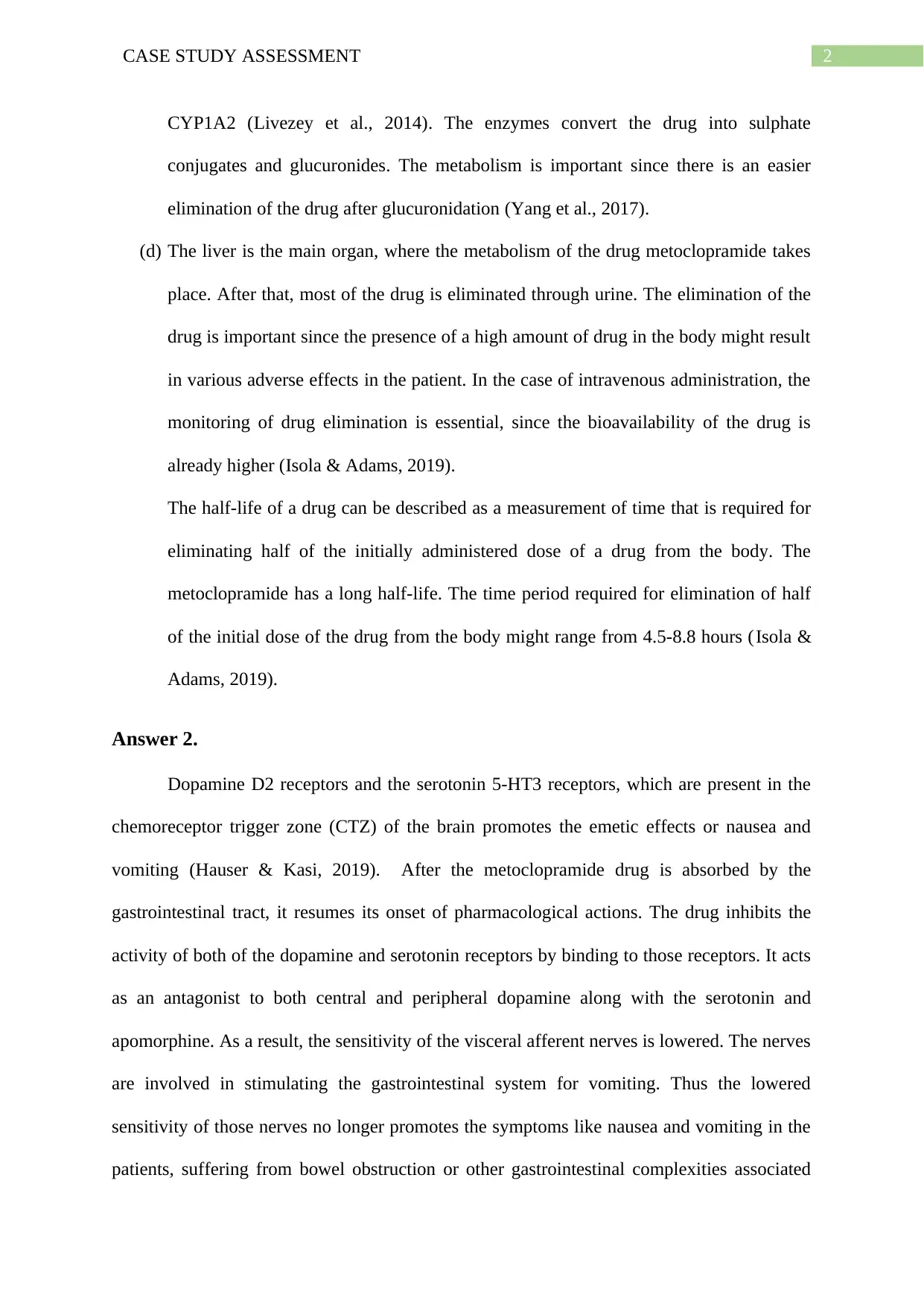
2CASE STUDY ASSESSMENT
CYP1A2 (Livezey et al., 2014). The enzymes convert the drug into sulphate
conjugates and glucuronides. The metabolism is important since there is an easier
elimination of the drug after glucuronidation (Yang et al., 2017).
(d) The liver is the main organ, where the metabolism of the drug metoclopramide takes
place. After that, most of the drug is eliminated through urine. The elimination of the
drug is important since the presence of a high amount of drug in the body might result
in various adverse effects in the patient. In the case of intravenous administration, the
monitoring of drug elimination is essential, since the bioavailability of the drug is
already higher (Isola & Adams, 2019).
The half-life of a drug can be described as a measurement of time that is required for
eliminating half of the initially administered dose of a drug from the body. The
metoclopramide has a long half-life. The time period required for elimination of half
of the initial dose of the drug from the body might range from 4.5-8.8 hours (Isola &
Adams, 2019).
Answer 2.
Dopamine D2 receptors and the serotonin 5-HT3 receptors, which are present in the
chemoreceptor trigger zone (CTZ) of the brain promotes the emetic effects or nausea and
vomiting (Hauser & Kasi, 2019). After the metoclopramide drug is absorbed by the
gastrointestinal tract, it resumes its onset of pharmacological actions. The drug inhibits the
activity of both of the dopamine and serotonin receptors by binding to those receptors. It acts
as an antagonist to both central and peripheral dopamine along with the serotonin and
apomorphine. As a result, the sensitivity of the visceral afferent nerves is lowered. The nerves
are involved in stimulating the gastrointestinal system for vomiting. Thus the lowered
sensitivity of those nerves no longer promotes the symptoms like nausea and vomiting in the
patients, suffering from bowel obstruction or other gastrointestinal complexities associated
CYP1A2 (Livezey et al., 2014). The enzymes convert the drug into sulphate
conjugates and glucuronides. The metabolism is important since there is an easier
elimination of the drug after glucuronidation (Yang et al., 2017).
(d) The liver is the main organ, where the metabolism of the drug metoclopramide takes
place. After that, most of the drug is eliminated through urine. The elimination of the
drug is important since the presence of a high amount of drug in the body might result
in various adverse effects in the patient. In the case of intravenous administration, the
monitoring of drug elimination is essential, since the bioavailability of the drug is
already higher (Isola & Adams, 2019).
The half-life of a drug can be described as a measurement of time that is required for
eliminating half of the initially administered dose of a drug from the body. The
metoclopramide has a long half-life. The time period required for elimination of half
of the initial dose of the drug from the body might range from 4.5-8.8 hours (Isola &
Adams, 2019).
Answer 2.
Dopamine D2 receptors and the serotonin 5-HT3 receptors, which are present in the
chemoreceptor trigger zone (CTZ) of the brain promotes the emetic effects or nausea and
vomiting (Hauser & Kasi, 2019). After the metoclopramide drug is absorbed by the
gastrointestinal tract, it resumes its onset of pharmacological actions. The drug inhibits the
activity of both of the dopamine and serotonin receptors by binding to those receptors. It acts
as an antagonist to both central and peripheral dopamine along with the serotonin and
apomorphine. As a result, the sensitivity of the visceral afferent nerves is lowered. The nerves
are involved in stimulating the gastrointestinal system for vomiting. Thus the lowered
sensitivity of those nerves no longer promotes the symptoms like nausea and vomiting in the
patients, suffering from bowel obstruction or other gastrointestinal complexities associated
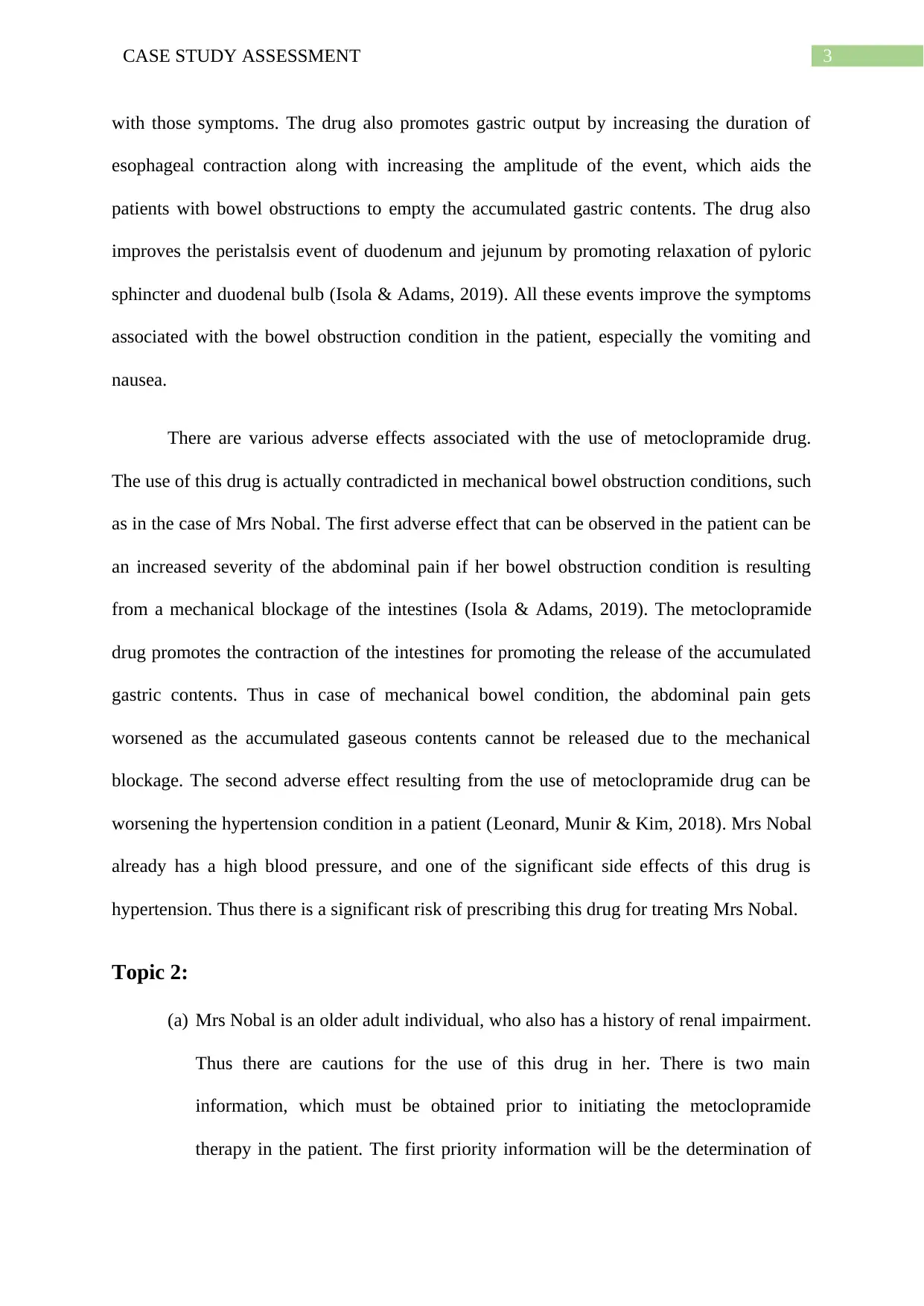
3CASE STUDY ASSESSMENT
with those symptoms. The drug also promotes gastric output by increasing the duration of
esophageal contraction along with increasing the amplitude of the event, which aids the
patients with bowel obstructions to empty the accumulated gastric contents. The drug also
improves the peristalsis event of duodenum and jejunum by promoting relaxation of pyloric
sphincter and duodenal bulb (Isola & Adams, 2019). All these events improve the symptoms
associated with the bowel obstruction condition in the patient, especially the vomiting and
nausea.
There are various adverse effects associated with the use of metoclopramide drug.
The use of this drug is actually contradicted in mechanical bowel obstruction conditions, such
as in the case of Mrs Nobal. The first adverse effect that can be observed in the patient can be
an increased severity of the abdominal pain if her bowel obstruction condition is resulting
from a mechanical blockage of the intestines (Isola & Adams, 2019). The metoclopramide
drug promotes the contraction of the intestines for promoting the release of the accumulated
gastric contents. Thus in case of mechanical bowel condition, the abdominal pain gets
worsened as the accumulated gaseous contents cannot be released due to the mechanical
blockage. The second adverse effect resulting from the use of metoclopramide drug can be
worsening the hypertension condition in a patient (Leonard, Munir & Kim, 2018). Mrs Nobal
already has a high blood pressure, and one of the significant side effects of this drug is
hypertension. Thus there is a significant risk of prescribing this drug for treating Mrs Nobal.
Topic 2:
(a) Mrs Nobal is an older adult individual, who also has a history of renal impairment.
Thus there are cautions for the use of this drug in her. There is two main
information, which must be obtained prior to initiating the metoclopramide
therapy in the patient. The first priority information will be the determination of
with those symptoms. The drug also promotes gastric output by increasing the duration of
esophageal contraction along with increasing the amplitude of the event, which aids the
patients with bowel obstructions to empty the accumulated gastric contents. The drug also
improves the peristalsis event of duodenum and jejunum by promoting relaxation of pyloric
sphincter and duodenal bulb (Isola & Adams, 2019). All these events improve the symptoms
associated with the bowel obstruction condition in the patient, especially the vomiting and
nausea.
There are various adverse effects associated with the use of metoclopramide drug.
The use of this drug is actually contradicted in mechanical bowel obstruction conditions, such
as in the case of Mrs Nobal. The first adverse effect that can be observed in the patient can be
an increased severity of the abdominal pain if her bowel obstruction condition is resulting
from a mechanical blockage of the intestines (Isola & Adams, 2019). The metoclopramide
drug promotes the contraction of the intestines for promoting the release of the accumulated
gastric contents. Thus in case of mechanical bowel condition, the abdominal pain gets
worsened as the accumulated gaseous contents cannot be released due to the mechanical
blockage. The second adverse effect resulting from the use of metoclopramide drug can be
worsening the hypertension condition in a patient (Leonard, Munir & Kim, 2018). Mrs Nobal
already has a high blood pressure, and one of the significant side effects of this drug is
hypertension. Thus there is a significant risk of prescribing this drug for treating Mrs Nobal.
Topic 2:
(a) Mrs Nobal is an older adult individual, who also has a history of renal impairment.
Thus there are cautions for the use of this drug in her. There is two main
information, which must be obtained prior to initiating the metoclopramide
therapy in the patient. The first priority information will be the determination of
Secure Best Marks with AI Grader
Need help grading? Try our AI Grader for instant feedback on your assignments.
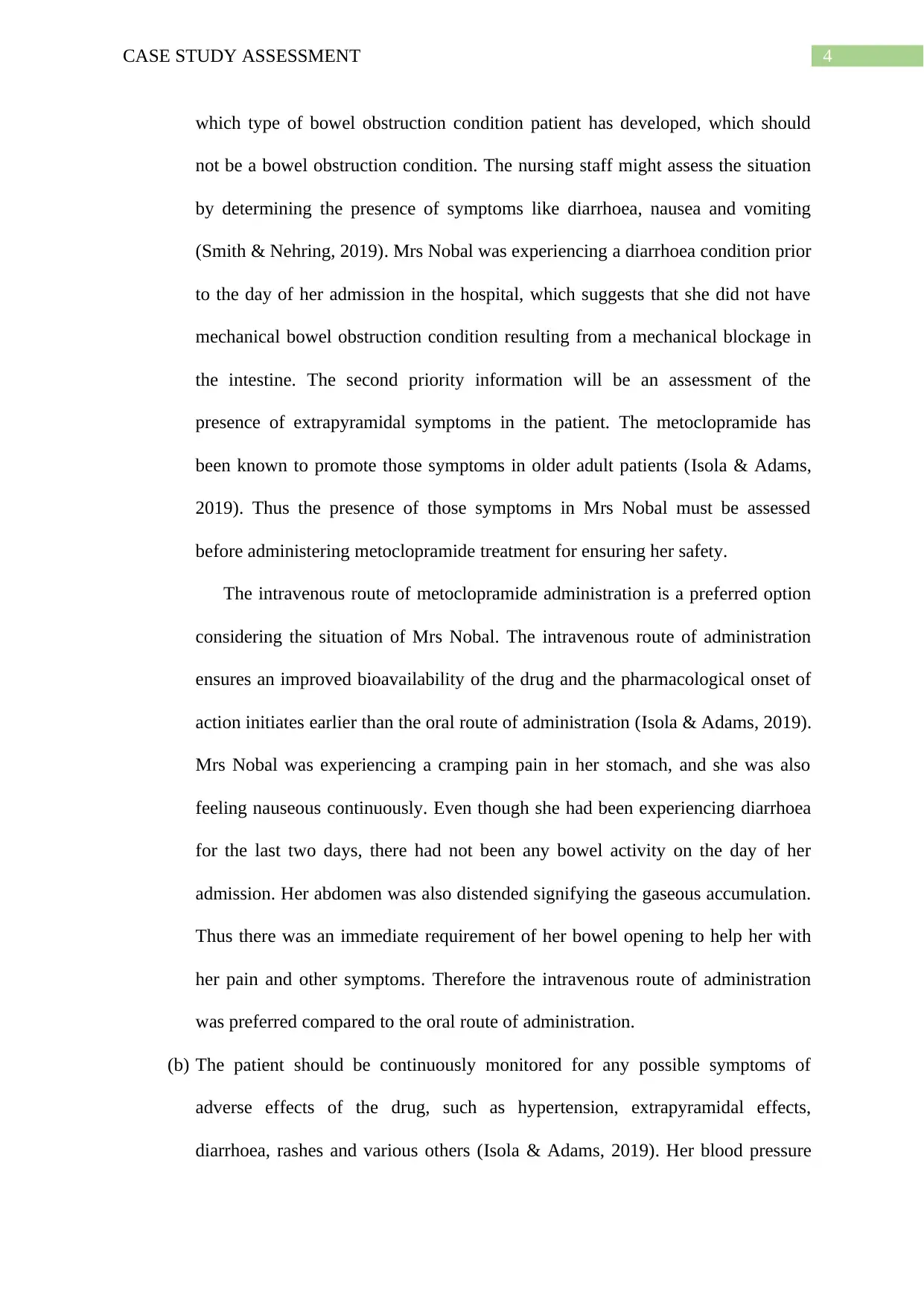
4CASE STUDY ASSESSMENT
which type of bowel obstruction condition patient has developed, which should
not be a bowel obstruction condition. The nursing staff might assess the situation
by determining the presence of symptoms like diarrhoea, nausea and vomiting
(Smith & Nehring, 2019). Mrs Nobal was experiencing a diarrhoea condition prior
to the day of her admission in the hospital, which suggests that she did not have
mechanical bowel obstruction condition resulting from a mechanical blockage in
the intestine. The second priority information will be an assessment of the
presence of extrapyramidal symptoms in the patient. The metoclopramide has
been known to promote those symptoms in older adult patients (Isola & Adams,
2019). Thus the presence of those symptoms in Mrs Nobal must be assessed
before administering metoclopramide treatment for ensuring her safety.
The intravenous route of metoclopramide administration is a preferred option
considering the situation of Mrs Nobal. The intravenous route of administration
ensures an improved bioavailability of the drug and the pharmacological onset of
action initiates earlier than the oral route of administration (Isola & Adams, 2019).
Mrs Nobal was experiencing a cramping pain in her stomach, and she was also
feeling nauseous continuously. Even though she had been experiencing diarrhoea
for the last two days, there had not been any bowel activity on the day of her
admission. Her abdomen was also distended signifying the gaseous accumulation.
Thus there was an immediate requirement of her bowel opening to help her with
her pain and other symptoms. Therefore the intravenous route of administration
was preferred compared to the oral route of administration.
(b) The patient should be continuously monitored for any possible symptoms of
adverse effects of the drug, such as hypertension, extrapyramidal effects,
diarrhoea, rashes and various others (Isola & Adams, 2019). Her blood pressure
which type of bowel obstruction condition patient has developed, which should
not be a bowel obstruction condition. The nursing staff might assess the situation
by determining the presence of symptoms like diarrhoea, nausea and vomiting
(Smith & Nehring, 2019). Mrs Nobal was experiencing a diarrhoea condition prior
to the day of her admission in the hospital, which suggests that she did not have
mechanical bowel obstruction condition resulting from a mechanical blockage in
the intestine. The second priority information will be an assessment of the
presence of extrapyramidal symptoms in the patient. The metoclopramide has
been known to promote those symptoms in older adult patients (Isola & Adams,
2019). Thus the presence of those symptoms in Mrs Nobal must be assessed
before administering metoclopramide treatment for ensuring her safety.
The intravenous route of metoclopramide administration is a preferred option
considering the situation of Mrs Nobal. The intravenous route of administration
ensures an improved bioavailability of the drug and the pharmacological onset of
action initiates earlier than the oral route of administration (Isola & Adams, 2019).
Mrs Nobal was experiencing a cramping pain in her stomach, and she was also
feeling nauseous continuously. Even though she had been experiencing diarrhoea
for the last two days, there had not been any bowel activity on the day of her
admission. Her abdomen was also distended signifying the gaseous accumulation.
Thus there was an immediate requirement of her bowel opening to help her with
her pain and other symptoms. Therefore the intravenous route of administration
was preferred compared to the oral route of administration.
(b) The patient should be continuously monitored for any possible symptoms of
adverse effects of the drug, such as hypertension, extrapyramidal effects,
diarrhoea, rashes and various others (Isola & Adams, 2019). Her blood pressure
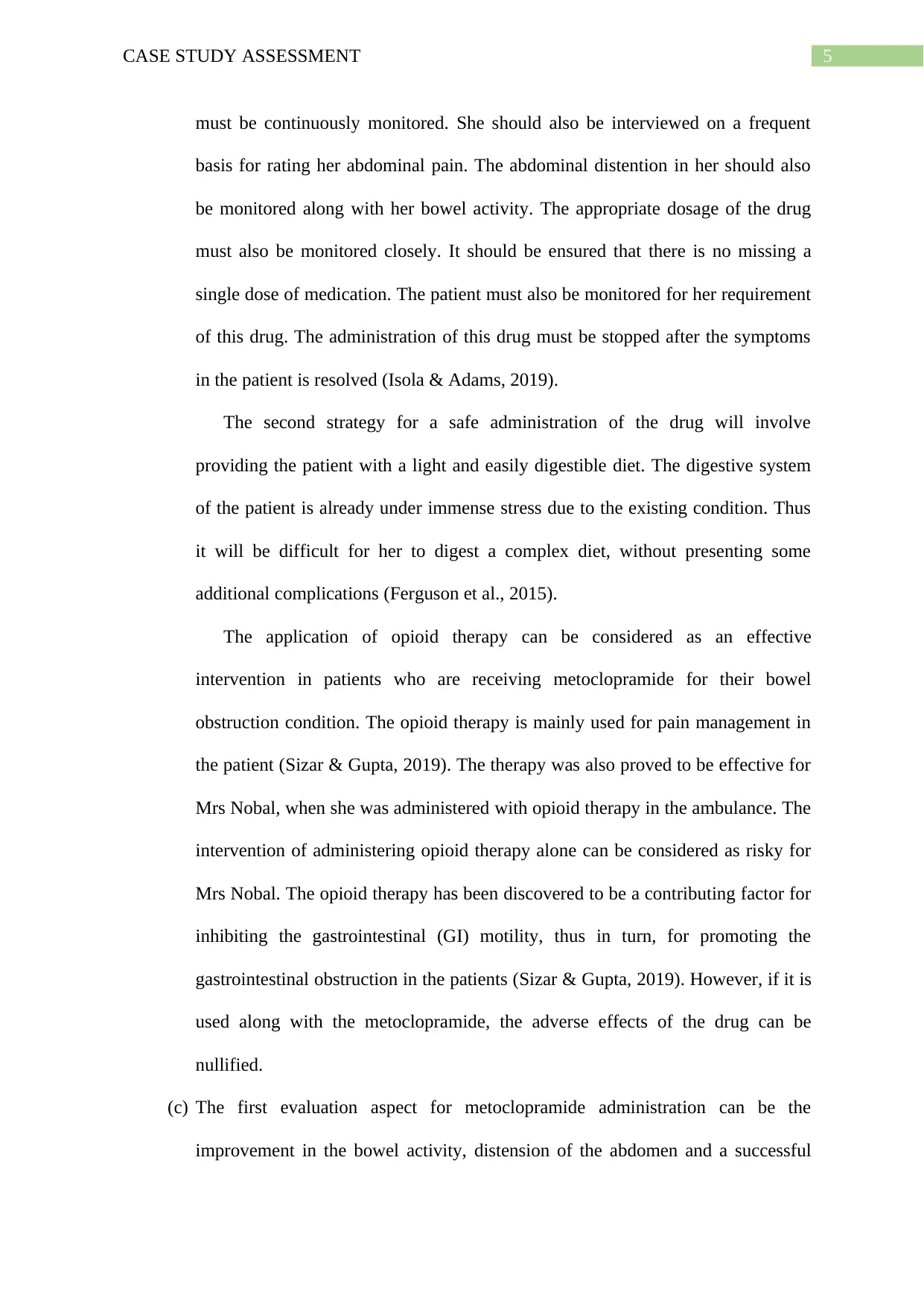
5CASE STUDY ASSESSMENT
must be continuously monitored. She should also be interviewed on a frequent
basis for rating her abdominal pain. The abdominal distention in her should also
be monitored along with her bowel activity. The appropriate dosage of the drug
must also be monitored closely. It should be ensured that there is no missing a
single dose of medication. The patient must also be monitored for her requirement
of this drug. The administration of this drug must be stopped after the symptoms
in the patient is resolved (Isola & Adams, 2019).
The second strategy for a safe administration of the drug will involve
providing the patient with a light and easily digestible diet. The digestive system
of the patient is already under immense stress due to the existing condition. Thus
it will be difficult for her to digest a complex diet, without presenting some
additional complications (Ferguson et al., 2015).
The application of opioid therapy can be considered as an effective
intervention in patients who are receiving metoclopramide for their bowel
obstruction condition. The opioid therapy is mainly used for pain management in
the patient (Sizar & Gupta, 2019). The therapy was also proved to be effective for
Mrs Nobal, when she was administered with opioid therapy in the ambulance. The
intervention of administering opioid therapy alone can be considered as risky for
Mrs Nobal. The opioid therapy has been discovered to be a contributing factor for
inhibiting the gastrointestinal (GI) motility, thus in turn, for promoting the
gastrointestinal obstruction in the patients (Sizar & Gupta, 2019). However, if it is
used along with the metoclopramide, the adverse effects of the drug can be
nullified.
(c) The first evaluation aspect for metoclopramide administration can be the
improvement in the bowel activity, distension of the abdomen and a successful
must be continuously monitored. She should also be interviewed on a frequent
basis for rating her abdominal pain. The abdominal distention in her should also
be monitored along with her bowel activity. The appropriate dosage of the drug
must also be monitored closely. It should be ensured that there is no missing a
single dose of medication. The patient must also be monitored for her requirement
of this drug. The administration of this drug must be stopped after the symptoms
in the patient is resolved (Isola & Adams, 2019).
The second strategy for a safe administration of the drug will involve
providing the patient with a light and easily digestible diet. The digestive system
of the patient is already under immense stress due to the existing condition. Thus
it will be difficult for her to digest a complex diet, without presenting some
additional complications (Ferguson et al., 2015).
The application of opioid therapy can be considered as an effective
intervention in patients who are receiving metoclopramide for their bowel
obstruction condition. The opioid therapy is mainly used for pain management in
the patient (Sizar & Gupta, 2019). The therapy was also proved to be effective for
Mrs Nobal, when she was administered with opioid therapy in the ambulance. The
intervention of administering opioid therapy alone can be considered as risky for
Mrs Nobal. The opioid therapy has been discovered to be a contributing factor for
inhibiting the gastrointestinal (GI) motility, thus in turn, for promoting the
gastrointestinal obstruction in the patients (Sizar & Gupta, 2019). However, if it is
used along with the metoclopramide, the adverse effects of the drug can be
nullified.
(c) The first evaluation aspect for metoclopramide administration can be the
improvement in the bowel activity, distension of the abdomen and a successful
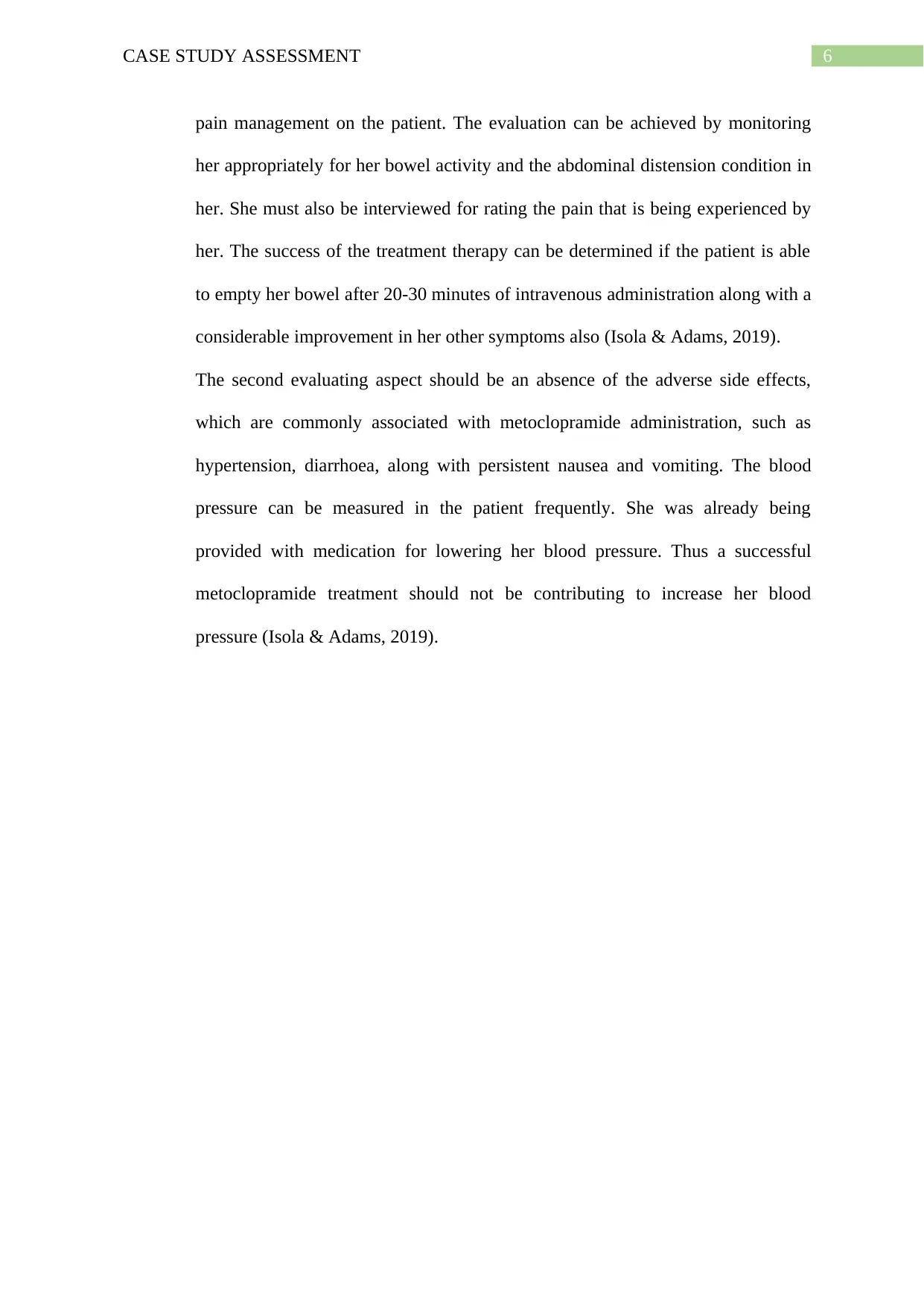
6CASE STUDY ASSESSMENT
pain management on the patient. The evaluation can be achieved by monitoring
her appropriately for her bowel activity and the abdominal distension condition in
her. She must also be interviewed for rating the pain that is being experienced by
her. The success of the treatment therapy can be determined if the patient is able
to empty her bowel after 20-30 minutes of intravenous administration along with a
considerable improvement in her other symptoms also (Isola & Adams, 2019).
The second evaluating aspect should be an absence of the adverse side effects,
which are commonly associated with metoclopramide administration, such as
hypertension, diarrhoea, along with persistent nausea and vomiting. The blood
pressure can be measured in the patient frequently. She was already being
provided with medication for lowering her blood pressure. Thus a successful
metoclopramide treatment should not be contributing to increase her blood
pressure (Isola & Adams, 2019).
pain management on the patient. The evaluation can be achieved by monitoring
her appropriately for her bowel activity and the abdominal distension condition in
her. She must also be interviewed for rating the pain that is being experienced by
her. The success of the treatment therapy can be determined if the patient is able
to empty her bowel after 20-30 minutes of intravenous administration along with a
considerable improvement in her other symptoms also (Isola & Adams, 2019).
The second evaluating aspect should be an absence of the adverse side effects,
which are commonly associated with metoclopramide administration, such as
hypertension, diarrhoea, along with persistent nausea and vomiting. The blood
pressure can be measured in the patient frequently. She was already being
provided with medication for lowering her blood pressure. Thus a successful
metoclopramide treatment should not be contributing to increase her blood
pressure (Isola & Adams, 2019).
Paraphrase This Document
Need a fresh take? Get an instant paraphrase of this document with our AI Paraphraser
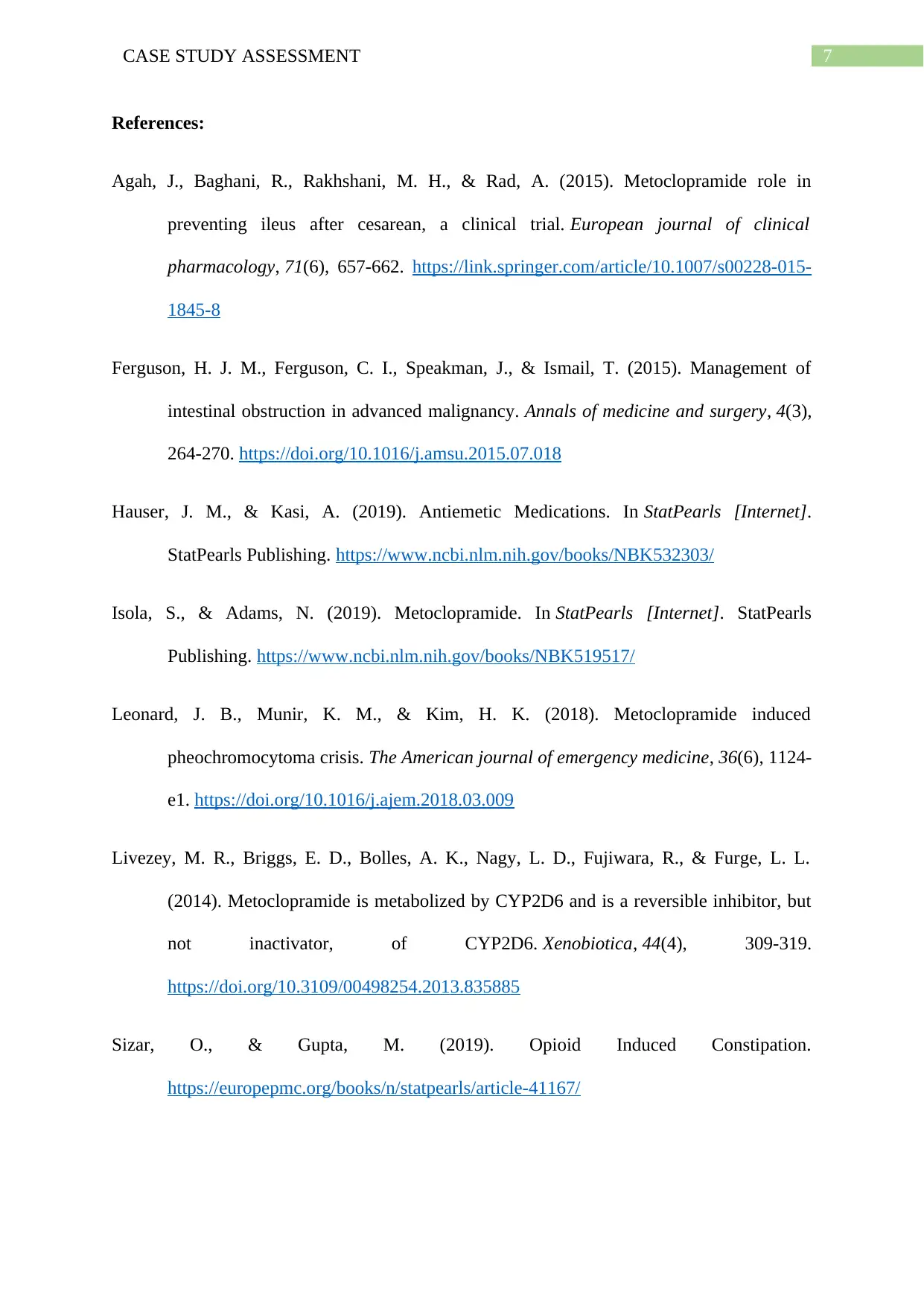
7CASE STUDY ASSESSMENT
References:
Agah, J., Baghani, R., Rakhshani, M. H., & Rad, A. (2015). Metoclopramide role in
preventing ileus after cesarean, a clinical trial. European journal of clinical
pharmacology, 71(6), 657-662. https://link.springer.com/article/10.1007/s00228-015-
1845-8
Ferguson, H. J. M., Ferguson, C. I., Speakman, J., & Ismail, T. (2015). Management of
intestinal obstruction in advanced malignancy. Annals of medicine and surgery, 4(3),
264-270. https://doi.org/10.1016/j.amsu.2015.07.018
Hauser, J. M., & Kasi, A. (2019). Antiemetic Medications. In StatPearls [Internet].
StatPearls Publishing. https://www.ncbi.nlm.nih.gov/books/NBK532303/
Isola, S., & Adams, N. (2019). Metoclopramide. In StatPearls [Internet]. StatPearls
Publishing. https://www.ncbi.nlm.nih.gov/books/NBK519517/
Leonard, J. B., Munir, K. M., & Kim, H. K. (2018). Metoclopramide induced
pheochromocytoma crisis. The American journal of emergency medicine, 36(6), 1124-
e1. https://doi.org/10.1016/j.ajem.2018.03.009
Livezey, M. R., Briggs, E. D., Bolles, A. K., Nagy, L. D., Fujiwara, R., & Furge, L. L.
(2014). Metoclopramide is metabolized by CYP2D6 and is a reversible inhibitor, but
not inactivator, of CYP2D6. Xenobiotica, 44(4), 309-319.
https://doi.org/10.3109/00498254.2013.835885
Sizar, O., & Gupta, M. (2019). Opioid Induced Constipation.
https://europepmc.org/books/n/statpearls/article-41167/
References:
Agah, J., Baghani, R., Rakhshani, M. H., & Rad, A. (2015). Metoclopramide role in
preventing ileus after cesarean, a clinical trial. European journal of clinical
pharmacology, 71(6), 657-662. https://link.springer.com/article/10.1007/s00228-015-
1845-8
Ferguson, H. J. M., Ferguson, C. I., Speakman, J., & Ismail, T. (2015). Management of
intestinal obstruction in advanced malignancy. Annals of medicine and surgery, 4(3),
264-270. https://doi.org/10.1016/j.amsu.2015.07.018
Hauser, J. M., & Kasi, A. (2019). Antiemetic Medications. In StatPearls [Internet].
StatPearls Publishing. https://www.ncbi.nlm.nih.gov/books/NBK532303/
Isola, S., & Adams, N. (2019). Metoclopramide. In StatPearls [Internet]. StatPearls
Publishing. https://www.ncbi.nlm.nih.gov/books/NBK519517/
Leonard, J. B., Munir, K. M., & Kim, H. K. (2018). Metoclopramide induced
pheochromocytoma crisis. The American journal of emergency medicine, 36(6), 1124-
e1. https://doi.org/10.1016/j.ajem.2018.03.009
Livezey, M. R., Briggs, E. D., Bolles, A. K., Nagy, L. D., Fujiwara, R., & Furge, L. L.
(2014). Metoclopramide is metabolized by CYP2D6 and is a reversible inhibitor, but
not inactivator, of CYP2D6. Xenobiotica, 44(4), 309-319.
https://doi.org/10.3109/00498254.2013.835885
Sizar, O., & Gupta, M. (2019). Opioid Induced Constipation.
https://europepmc.org/books/n/statpearls/article-41167/
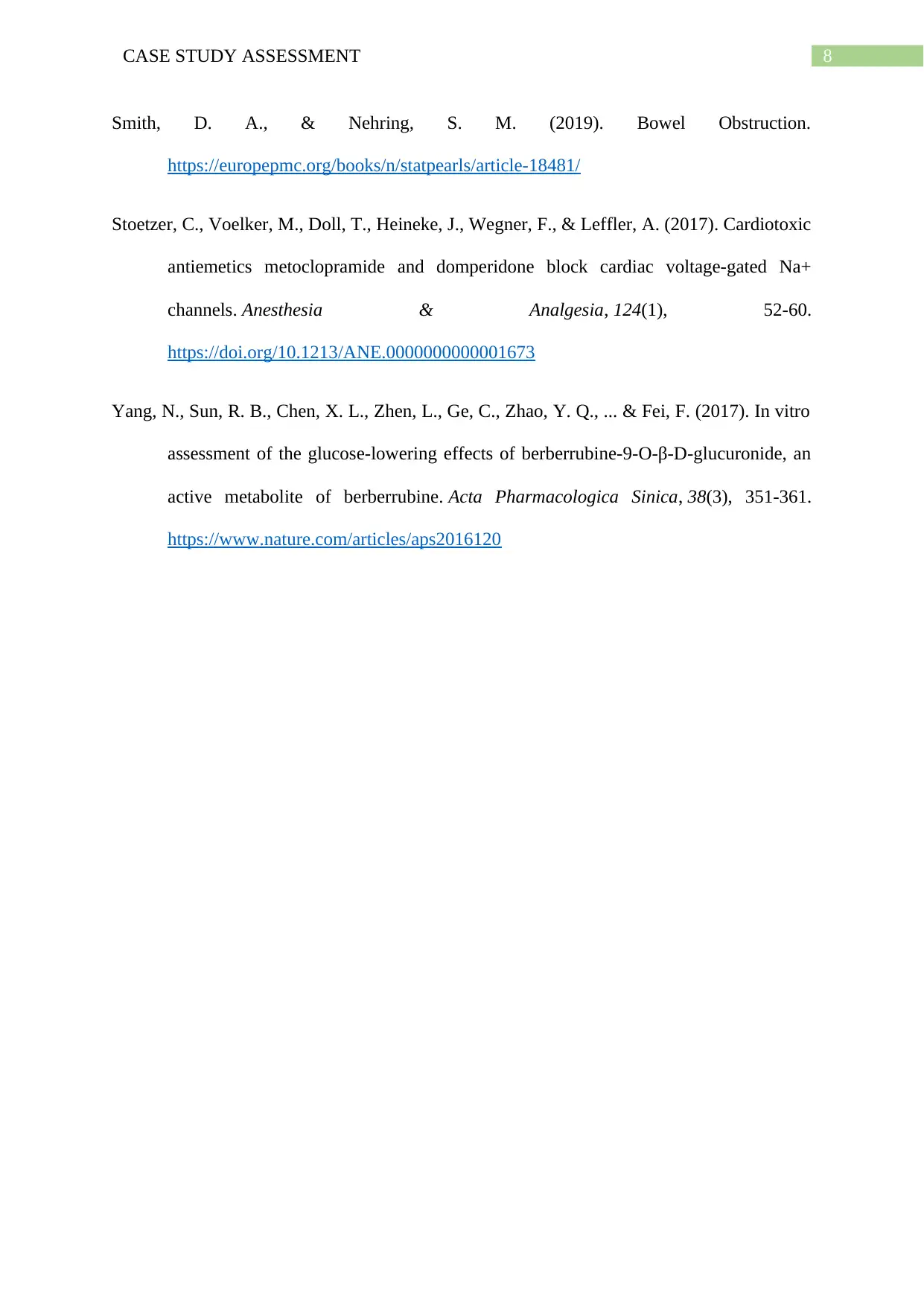
8CASE STUDY ASSESSMENT
Smith, D. A., & Nehring, S. M. (2019). Bowel Obstruction.
https://europepmc.org/books/n/statpearls/article-18481/
Stoetzer, C., Voelker, M., Doll, T., Heineke, J., Wegner, F., & Leffler, A. (2017). Cardiotoxic
antiemetics metoclopramide and domperidone block cardiac voltage-gated Na+
channels. Anesthesia & Analgesia, 124(1), 52-60.
https://doi.org/10.1213/ANE.0000000000001673
Yang, N., Sun, R. B., Chen, X. L., Zhen, L., Ge, C., Zhao, Y. Q., ... & Fei, F. (2017). In vitro
assessment of the glucose-lowering effects of berberrubine-9-O-β-D-glucuronide, an
active metabolite of berberrubine. Acta Pharmacologica Sinica, 38(3), 351-361.
https://www.nature.com/articles/aps2016120
Smith, D. A., & Nehring, S. M. (2019). Bowel Obstruction.
https://europepmc.org/books/n/statpearls/article-18481/
Stoetzer, C., Voelker, M., Doll, T., Heineke, J., Wegner, F., & Leffler, A. (2017). Cardiotoxic
antiemetics metoclopramide and domperidone block cardiac voltage-gated Na+
channels. Anesthesia & Analgesia, 124(1), 52-60.
https://doi.org/10.1213/ANE.0000000000001673
Yang, N., Sun, R. B., Chen, X. L., Zhen, L., Ge, C., Zhao, Y. Q., ... & Fei, F. (2017). In vitro
assessment of the glucose-lowering effects of berberrubine-9-O-β-D-glucuronide, an
active metabolite of berberrubine. Acta Pharmacologica Sinica, 38(3), 351-361.
https://www.nature.com/articles/aps2016120
1 out of 9
Related Documents
Your All-in-One AI-Powered Toolkit for Academic Success.
+13062052269
info@desklib.com
Available 24*7 on WhatsApp / Email
![[object Object]](/_next/static/media/star-bottom.7253800d.svg)
Unlock your academic potential
© 2024 | Zucol Services PVT LTD | All rights reserved.





